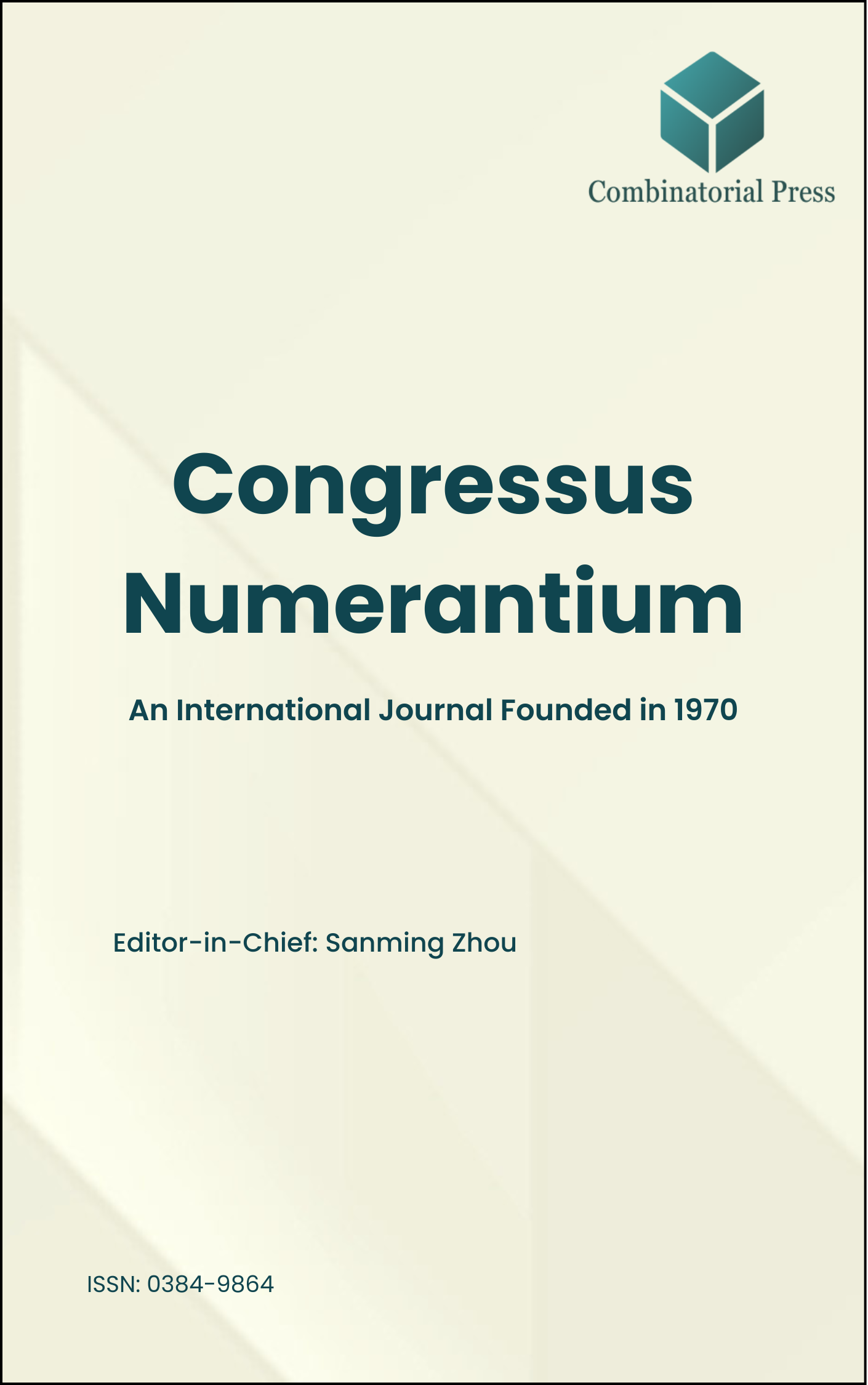
Congressus Numerantium
ISSN: 0384-9864
Established in 1970, Congressus Numerantium is one of the oldest international journals with a focus on publishing high-quality papers in combinatorics and related areas. Over the years, it has published numerous fully refereed regular papers and conference proceedings for many prestigious conferences. However, publication was temporarily paused on January 15, 2020. Throughout its active years, Congressus Numerantium adopted a print format, following a subscription-based model for readers and releasing 234 Volumes. Despite the changing landscape of academic publishing, Congressus Numerantium demonstrated resilience. In 2024, the journal embarked on a transformative journey, reemerging in both print and online formats with the objective of publishing 2 volumes annually, scheduled for release in June and December. We cordially invite original research papers and survey articles, welcoming significant contributions to both the pure and applied aspects of combinatorics. Furthermore, we extend a warm invitation for special issues dedicated to conferences and workshops in combinatorics and related fields, carrying forward the rich tradition of this esteemed journal. Special issues on selected topics of current interest to the community of combinatorics are also welcome.
- Research article
- Full Text
- Congressus Numerantium
- Volume 234
- Pages: 39-46
- Published: 31/12/2019
Let \( N_2DL(v) \) denote the set of degrees of vertices at distance \( 2 \) from \( v \). The \( 2 \)-neighborhood degree list of a graph is a listing of \( N_2DL(v) \) for every vertex \( v \). A degree restricted \( 2 \)-switch on edges \( v_1v_2 \) and \( w_1w_2 \), where \( \deg(v_1) = \deg(w_1) \) and \( \deg(v_2) = \deg(w_2) \), is the replacement of a pair of edges \( v_1v_2 \) and \( w_1w_2 \) by the edges \( v_1w_2 \) and \( v_2w_1 \), given that \( v_1w_2 \) and \( v_2w_1 \) did not appear in the graph originally. Let \( G \) and \( H \) be two graphs of diameter \( 2 \) on the same vertex set. We prove that \( G \) and \( H \) have the same \( 2 \)-neighborhood degree list if and only if \( G \) can be transformed into \( H \) by a sequence of degree restricted \( 2 \)-switches.
- Research article
- Full Text
- Congressus Numerantium
- Volume 234
- Pages: 9-38
- Published: 31/12/2019
- Research article
- Full Text
- Congressus Numerantium
- Volume 234
- Pages: 3-8
- Published: 31/12/2019
- Research article
- Full Text
- Congressus Numerantium
- Volume 233
- Pages: 255-262
- Published: 31/12/2019
Let \( \Gamma \) be a finite group and let \( \Delta \) be a generating set for \( \Gamma \). A Cayley map is an orientable 2-cell imbedding of the Cayley graph \( G_\Delta(\Gamma) \) such that the rotation of arcs emanating from each vertex is determined by a unique cyclic permutation of generators and their inverses. A probability model for the set of all Cayley maps for a fixed group and generating set, where the distribution is uniform. We focus on certain finite abelian groups with generating set chosen as the standard basis. A lower bound is provided for the probability that a Cayley map for such a group and generating set is symmetrical.
- Research article
- Full Text
- Congressus Numerantium
- Volume 233
- Pages: 245-254
- Published: 31/12/2019
A graph is asymmetric if the automorphism group of its set of vertices is trivial. A graph is called non-asymmetric if and only if it is not asymmetric. A graph \( G \) is minimally non-asymmetric if \( G \) is non-asymmetric but \( G – e \) is asymmetric for any edge \( e \) contained in \( G \).
Given a finite set \( V \) (of elements called varieties) and integers \( k \), \( r \), and \( \lambda \), a balanced incomplete block design (BIBD) is a family of \( k \)-element subsets of \( V \), called blocks, such that any element is contained in \( r \) blocks and any pair of distinct varieties \( u \) and \( w \) is contained in exactly \( \lambda \) blocks.
In this paper, we give examples of minimally non-asymmetric graphs constructed from balanced incomplete block designs.
- Research article
- Full Text
- Congressus Numerantium
- Volume 233
- Pages: 223-244
- Published: 31/12/2019
There is a special case of a generalized Clifford algebra, known as a Clifford graph algebra, which is useful for studying a simple graph \( G_n \), with \( n \) vertices. We will discuss how this algebra \( GA(G_n) \) can represent \( G_n \), and prove that it exists in general by defining it as an appropriate sub-algebra of a classical Clifford algebra. We will then refine this process of “construction by inclusion” for the path graph \( P_n \), and the complete star graph \( K_{1,n} \), by choosing from a parent classical Clifford algebra as many bi-vectors as possible for the generators which define \( GA(P_n) \) and \( GA(K_{1,n}) \).
- Research article
- Full Text
- Congressus Numerantium
- Volume 233
- Pages: 195-204
- Published: 31/12/2019
Elements of the Riordan group \(\mathcal{R}\) over a field \(\mathbb{F}\) of characteristic zero are infinite lower triangular matrices which are defined in terms of pairs of formal power series. We wish to bring to the forefront, as a tool in the theory of Riordan groups, the use of multiplicative roots \(a(x)^{\frac{1}{n}}\) of elements \(a(x)\) in the ring of formal power series over \(\mathbb{F}\). Using roots, we give a Normal Form for non-constant formal power series, we prove a surprisingly simple Composition-Cancellation Theorem and apply this to show that, for a major class of Riordan elements (i.e., for non-constant \(g(x)\) and appropriate \(F(x)\)), only one of the two basic conditions for checking that \((g(x), F(x))\) has order \(n\) in the group \(\mathcal{R}\) actually needs to be checked. Using all this, our main result is to generalize C. Marshall [6] and prove: Given non-constant \(g(x)\) satisfying necessary conditions, there exists a unique \(F(x)\), given by an explicit formula, such that \((g(x), F(x))\) is an involution in \(\mathcal{R}\). Finally, as examples, we apply this theorem to “aerated” series \(h(x) = g(x^r)\) to find the unique \(K(x)\) such that \((h(x), K(x))\) is an involution.
- Research article
- Full Text
- Congressus Numerantium
- Volume 233
- Pages: 189-194
- Published: 31/12/2019
A mixed hypergraph is a triple \(\mathcal{H} = (X, \mathcal{C}, \mathcal{D})\), where \(X\) is the vertex set and each of \(\mathcal{C}\) and \(\mathcal{D}\) is a family of subsets of \(X\), the \(\mathcal{C}\)-edges and \(\mathcal{D}\)-edges, respectively. A proper \(k\)-coloring of \(\mathcal{H}\) is a mapping such that each \(\mathcal{C}\)-edge has two vertices with a common color and each \(\mathcal{D}\)-edge has two vertices with distinct colors. A mixed hypergraph \(\mathcal{H}\) is called circular if there exists a host cycle on the vertex set \(X\) such that every edge (\(\mathcal{C}\)- or \(\mathcal{D}\)-) induces a connected subgraph of this cycle. We propose an algorithm to color the \((3, 3)\)-uniform, complete, circular, mixed hypergraphs for every value in its feasible set. In doing so, we show: \(\chi(\mathcal{H}) = 2\) and \(\bar{\chi}(\mathcal{H}) = \frac{n}{2}\) when \(n\) is even and \(\bar{\chi}(\mathcal{H}) = \frac{n-1}{2}\) when \(n\) is odd.
- Research article
- Full Text
- Congressus Numerantium
- Volume 233
- Pages: 263-276
- Published: 31/12/2019
For a positive integer \( k \), let \( \mathcal{P}^*([k]) \) be the set of nonempty subsets of the set \( [k] = \{1, 2, \ldots, k\} \). For a connected graph \( G \) of order 3 or more, let \( c: E(G) \to \mathcal{P}^*([k]) \) be an edge coloring of \( G \) where adjacent edges may be colored the same. The induced vertex coloring \( c’: V(G) \to \mathcal{P}^*([k]) \) is defined by \( c'(v) = \bigcap_{e \in E_v} c(e) \), where \( E_v \) is the set of edges incident with \( v \). If \( c’ \) is a proper vertex coloring of \( G \), then \( c \) is called a regal \( k \)-edge coloring of \( G \). The minimum positive integer \( k \) for which a graph \( G \) has a regal \( k \)-edge coloring is the regal index \( \text{reg}(G) \) of \( G \). If \( c’ \) is vertex-distinguishing, then \( c \) is a strong regal \( k \)-edge coloring of \( G \). The minimum positive integer \( k \) for which \( G \) has a strong regal \( k \)-edge coloring is the strong regal index \( \text{sreg}(G) \) of \( G \). A brief survey of known results and conjectures on strong regal indexes of graphs is presented. The relationships between the regal index \( \text{reg}(G) \) and the chromatic number \( \chi(G) \) of a connected graph \( G \) are investigated and results and problems on \( \text{reg}(G) \) are presented.
- Research article
- Full Text
- Congressus Numerantium
- Volume 233
- Pages: 175-188
- Published: 31/12/2019
One of the routing paradigms on interconnection networks is as follows: given a source node and \(m\) destination nodes, find disjoint paths from the source to the destination nodes. If we impose the condition that these paths be the shortest ones, this problem becomes harder and more interesting because such shortest and disjoint paths do not always exist. This problem has been studied previously for \(Q_n\), the hypercube of dimension \(n\), when \(m = n\) and a necessary and sufficient condition has been found for these paths to exist. In this paper, we review the previous work for the hypercube and then consider the problem in the more general case for arbitrary \(m\), where \(1 \leq m \leq 2^n – 1\), in an \(n\)-cube by designing routing algorithms that always find disjoint and shortest paths for a maximum subset of the destination nodes for which such paths exist. The size of such a set is no more than \(n\), the degree of the \(Q_n\).





